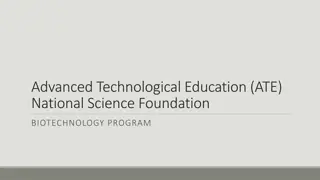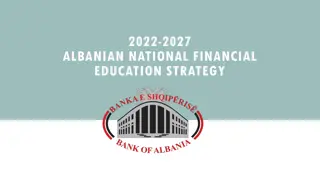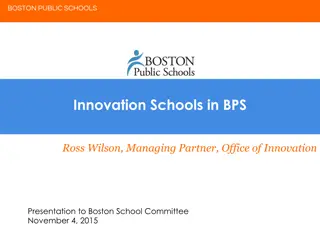Financial Education Integration in Schools: Strategic Decisions and Principles
Explore the importance and process of integrating financial education in school curriculums, focusing on strategic decisions and principles such as stakeholder involvement, sustainability, age groups, and impact evaluation. Learn about the necessity of introducing financial education at a young age and the key considerations for successful implementation in schools.
Download Presentation

Please find below an Image/Link to download the presentation.
The content on the website is provided AS IS for your information and personal use only. It may not be sold, licensed, or shared on other websites without obtaining consent from the author. Download presentation by click this link. If you encounter any issues during the download, it is possible that the publisher has removed the file from their server.
E N D
Presentation Transcript
FINANCIAL EDUCATION IN FINANCIAL EDUCATION IN SCHOOLS SCHOOLS Market Conduct Supervision Training Program Armenuhi Mkrtchyan 6-10 August 2018, Harare
O OVERVIEW VERVIEW Preconditions for effective introduction How to introduce effective FE in schools? What are the necessary preconditions? What cooperation mechanisms are needed for stakeholders? Process of Integration Stakeholder Management & Cooperation Mechanisms Core Competencies Subject Integration 2
WHY IN SCHOOLS WHY IN SCHOOLS people tend to learn best when they are young schoolchildren are a captive audience Adults often learn new from their children this helps to ensure that the next generation of adults are able to manage their personal finances well habits are formed at school people's attitudes to personal finances are often formed at an early age
S STRATEGIC TRATEGIC D DECISIONS ECISIONS Involvement Is MoE ready to introduce, help, facilitate? Consensus? Is central bank alone? All stkh-s involvement is more sustainable, however difficult to manage Modality If ingrained then which subjects? Separate subject easy to introduce. Number of subjects should be optimal. Balancing number of teachers to be trained with number of subjects? Costs for ToT, printing materials, etc. all stakeholders vs alone separate vs ingrained Sustainability Costs Age all vs limited grades Which grades? Primary, secondary, tertiary? Full years are more impactful. Scalability Imposition Obligatory as other classes or voluntarily after classes? Obligatory is more sustainable solution. funding How much will be cost of project? Donors? obligatory vs facultative Impact Who will pay for introduction?
PRINCIPLES OF INTEGRATION IN SCHOOLS PRINCIPLES OF INTEGRATION IN SCHOOLS Target: School students of all ages Financial education: compulsory in school Integration of financial education s elements in existing subjects /for every year/ Strong collaboration with Ministry of Education in elaboration of materials Pilot period in selected school before launching the program nationwide Method of education: practical (vs academic) knowledge, combined with games, seminars, visits to financial institutions etc. Evaluation and monitoring
P PROCESS ROCESSOF OF I INTEGRATING NTEGRATING Consensus & Cooperation Pilot & Implementa tion Training of Teachers Monitoring & Review Task Force Program Set up Core Competencies for school Elaborate Program for each subject Elaborate methodology to evaluate overall effectiveness of program Pilot Training of Teachers and classes in schools Define stakeholders Select subjects where FE be integrated Analyze and map teachers needs Build consensus, MOU, NSFE Set up Cooperation mechanism Strategy + Action Plan, including budget, timing, responsibles For each subject a working group (4-5 WGs) Feedback and review Elaborate Monitoring & Evaluation program for each subject Make continuous monitoring and evaluation Elaborate Program fro Teachers training, including Action Plan General coordination of task force Full scale launch Review the system Quality control for textbooks
CONSENSUS & COOPERATION CONSENSUS & COOPERATION S STAKEHOLDER TAKEHOLDER M MANAGEMENT ANAGEMENT raising the importance with top management 80% of success depends on stakeholder management It should be part of day-to-day mngt
C CONSENSUS ONSENSUS &C &COOPERATION OOPERATION Stakeholder Management is probably the most important component for successful FE projects. Its purpose: Raising importance, Take them on board, make feel them the ownership, be supportive and proactive Building consensus Government approved NSFE and/or Memorandum of understanding Consensus & Cooperation Define stakeholders Build consensus, MOU, NSFE Set up Cooperation mechanism Strategy + Action Plan
KEY CHALLENGES KEY CHALLENGES FOR AND ANDBUILDING BUILDINGCONSENSUS FORRAISING RAISINGIMPORTANCE CONSENSUS IMPORTANCE TOP MANAGEMENT Show results, easy wins Voice mass media pressure Bring authorities NO SUPPORT no belief hope COLLEAGUES No belief Attitude of cooperation EXTERNALS HIDDEN SABOTAGE Patience no trust, jealousy most asymmetry of information Transparency
S STAKEHOLDER TAKEHOLDER M MANAGEMENT ANAGEMENT F FRAMEWORK RAMEWORK Communication Strategy & Planning Engagement Strategies & Techniques Continuous Assessment & Follow up Stakeholder Mapping Identify key stakeholders Review methods to inform different groups of stakeholders including timing & frequency Clarification of roles and responsibilities for SHM Define stakeholders concerns and issues, hidden agendas, what information they require Techniques to involve the stakeholders in design and implementation Make a communication plan and create continuous dialog with stakeholders Assess their level of commitment and interest Assess their level of influence on project outcomes Validate & evaluate communication processes Obtain feedback and involvement
S STAKEHOLDER TAKEHOLDER M MANAGEMENT ANAGEMENT P PROCESS Assess & map Identify ROCESS Review Plan Act
Keep satisfied & move Key stakeholders: 4 2 to CB top mngt FSPs MoE Finance Ministry Municipality Other Government Central Bank team Some Donors (WB, AFI, SBFIC) S STAKEHOLDER TAKEHOLDER M MAPPING APPING POWER/INFLUENCE Main groups of stakeholders: CB - enough powerful to lead financial education Donor organizations/NGOs with direct mandate on FE Keep informed & move Involve as needed: 1 3 to Donor organizations with no direct mandate Population Interested bypassers CB colleagues Some donor orgs Public orgs Private sector Public sector with no direct mandate Interested by passers Not interested influential stakeholders (MoE, Govmnt) INTEREST
Awareness Engagement O OUR UR G GOAL OAL Reflection Motivation Unification, integration, synchronization of the efforts of stakeholders so as to provide unity of action in the pursuit of common goals. We do it by Self- Reciprocity synchronization Mediation Participation
D DIMENSIONS IMENSIONSOF OF G GOVERNANCE OVERNANCE COORDINATION To achieve a common activity COLLABORATION To create smth new Shared database Steering Committee Task forces Workflow My Finance Month School Project Rural project E-mail Messaging F-2-F Online Platform COMMUNICATION
PLACE TO COMMUNICATE TRANSPARENCY TRANSPARENCY IS IS KEY KEYTO TOBUILDING BUILDING CONSENSUS CONSENSUS Government CBA Online Face-to- face Platform- Basecamp EXTERNALS HIDDEN SABOTAGE no trust, jealousy most asymmetry of information Phone Emails Public others PROCESS TO COMMUNICATE What How Why How often every 3 months regularly Projects, inititatives Steering Committee Consult beforehand Build up confidence and mutual trust Eliminate asymmetry of information Build up ownership members of NSFE SC
O ON N- -L LINE INE P PLATFORM LATFORMIS ISKEY KEY All stakeholders All stakeholders Institutional memory Institutional memory Preparation of reports on the progress Preparation of reports on the progress of projects and protocols of projects and protocols Efficient and fast communication Efficient and fast communication Effective Action Planning Effective Action Planning Get informed Find partners Communicate
S STAKEHOLDER TAKEHOLDER M MNGT WHO NGT S STRATEGY TRATEGY Who are your stakeholders? STAKEHOLDER MNGT STRATEGY is a key document for the leading institution and it should answer 5Ws. What is the goal you want to reach with each? Why you need them? WHY What you gonna communicate? What key messages should be conveyed? Strategy may include also PRINCIPLES of communication. WHAT When you gonna to communicate? How often? WHEN ACTION PLAN is derived from Strategy, compiled for 1 year and includes responsible persons What channels? How you gonna communicate them? WHERE
LIST ALL INVOLVED EXERCISE: MAPPING STAKEHOLDERS EXERCISE: MAPPING STAKEHOLDERS ORGANIZE THEM INTO 4 GROUPS ASSIGN STRATEGY Stakeholder Group (1,2,3,4) Goal Communication channel/s F-2-F Email Frequency Respons ible 1 MOE 2 Move to group 4 Take ownership of NS Once a month Upon need 2 3 4 5 6 7 8 9 10 n
TASK FORCE TASK FORCE
S SUBJECT UBJECTINTEGRATION INTEGRATION: A : ARMENIA RMENIA C CASE ASE First step is choosing subjects to be integrated Subjects should be minimum necessary number, keep in mind training of teachers Those subjects should be selected that most can be fitted 1 2 3 4 5 6 7 8 9 10 11 12 Math Algebra Me and World Technology Social
T TASK ASK F FORCE ORCE Coordinator (Regulator) Coordinator (Ministry of Education) Psychologist Coordination Group Task Force Subject 1 WG Select subjects where FE be integrated Task Force WG Coordinator (Regulator) Expert on FE Expert on Subject (Ministry of Education) Teacher on Subject Subject 2 WG For each subject a working group (4- 5 WGs) Subject N WG General coordination of task force
PROGRAM PROGRAM
P PROGRAM ROGRAM Working Group of each subject under coordination should elaborate: Core competencies Comprehensive program which includes: Concept/philosophy Number of hours to be tought Pro-formas for each topic Evaluation methods Textbooks usually they are outsourced, but be aware of quality control Program Set up Core Competencies for school Elaborate Program for each subject Elaborate Monitoring & Evaluation program for each subject Quality control for textbooks
P PROGRAM ROGRAM Math K, S, A, B Philosophy, Principles Subject Programs Core Competencies Subjects matrix Curriculum Social 1-12 years Core competencies Outcomes How many classes/hours Pilot teaching Monitoring end evaluation Launch TOT Module for Training of teachers teachersMath Social Pilot training Selected schools Regional coverage
CORE CORE COMPETENCIES COMPETENCIES Core competencies are those minimum competencies (knowledge, skills, attitude, behaviors) that wanted the schoolchildren posses after graduating schools. Core Competencies for Adults Core Competencies for Schoolchilrden Adoption of core competencies for adults needed to make core competencies for schoolchildren: By capability components (K,S,A,B) Core Competencies for each subject By themes By age By subject (math, social )
C COMPETENCY OMPETENCY M MATRIX ATRIX - - ADULTS ADULTS Capability Knowledge Skills Attitude Behavior Themes Economy impact Budgeting Debt Management Savings and Long term Planning Right Protection Shopping around Anti- fraud
C COMPETENCY OMPETENCY M MARKET ARKET - - AFI AFI Source: Financial Capability Barometer, AFI
C COMPETENCY OMPETENCY M MATRIX ATRIX - - SCHOOLS SCHOOLS Capability 1-4 grades 5-7 grades 8-9 grades 10-12 grades Themes K S A B Economy Impact Budgeting Dept Management Savings and Long term Planning Right Protection Shopping around Anti- fraud
C COMPETENCY OMPETENCY M MATRIX ATRIXFOR FOR S SCHOOLS CHOOLS: A : ARMENIA RMENIA
TRAINING OF TEACHERS TRAINING OF TEACHERS
T TRAINING RAININGOF OFTEACHERS TEACHERS Training of Teachers Training teachers so that they have the knowledge, skills and confidence to provide effective financial education. Continuous training of teacher Preparation of methodical guidelines for teachers Pilot period for prepared materials Analyze and map teachers needs Elaborate Program fro Teachers training, including Action Plan
P PILOT ILOTAND AND I IMPLEMENTATION MPLEMENTATION Pilot the Programs in school Randomized Control Trials (RCT) can be used to asses the impact of Program Impact can be assessed both for kids program and for ToT program Based on RCT results review the Programs kids and ToT Make an Action Plan timing, responsibilities Train all teachers Launch Full scale Pilot & Implementation Pilot Training of Teachers and classes in schools Feedback and review Full scale launch
M MONITORING ONITORING & R & REVIEW EVIEW Each Subject has its own evaluating system However, overall effectiveness evaluation system should be elaborated No best practice yet Examples: Testing kids at the end of school Tracking behavior of kids after school Monitoring & Review Elaborate methodology to evaluate overall effectiveness of program Make contionous monitoring and evaluation Review the system
Q QUESTIONS UESTIONS? ? Armenuhi Mkrtchyan Head of Consumer Protection and Financial Education Centre, Central Bank of Armenia armenuhi.mkrtchyan@cba.am www.cba.am for Armenian legislation www.abcfinance.am financial education website
F FINANCIAL INANCIAL E EDUCATION Case of Armenia DUCATION I IN N S SCHOOLS CHOOLS
PROJECT SCOPE Ministry of Education and Science Implementation partners National Institute of Education Junior Achievements Armenia NGO 4 subject integration from 2 to 11 grades 1350 schools 11000 teachers Coverage is Nationwide 12+ experts engaged Preparations started in 2015
STEPS IMPLEMENTED 1. Competency matrix for learners 2015 2. Choosing subjects 2015 3. Expert group formation September - November, 2016 4. Subject FE Curriculum Development November, 2016 May, 2017 5. Training Module Development May August, 2017 6. Training for Pilot Teachers August, 2017 7. Pilot September, 2017 May, 2018
FINANCIAL EDUCATION CURRICULUM Primary school (2-4) Me and World Math Middle and high school Math (5-6) Algebra (7-11) Social studies (8-11) Subjects: Subject FE curriculum Training Module FE knowledge guide Teacher Manual Subject expert/ methodologist Expert group Financial literacy expert FE Content: Subject teacher/ practitioner Psychologist & Education expert
PILOT OF THE PROJECT Objectives: Evaluate the impact of curriculum on learners and teachers Evaluate the individual impact of each subject Noting the successes to build on Acknowledging challenges to amend or delete Setting priorities for the re-writing stage 13 schools 46 teachers 69 classes Methods: Focus groups Methodological guidance Class observations Regular feedback Collaborative meetings and discussions 1725 learners 1 academic year
STEERING COMMITTEE STEERING COMMITTEE The Steering Committee meet quarterly (or more frequently, if required) Chaired by RBZ or Co-chaired Be aware of rotating Chairs, collective responsibility Clear responsibility BOM Develo pment Orgs Other regulat ors SC Private sector NGOs Task Force Schools Task Force Adults Task Force Monitoring
W WHO 19 permanent members + >10 observers + guests CBA lead and coordination Government MoE, NIE, MoF, MoT, Municipality Private associations of banking, cred orgs, insurance Public Mediator, Deposit insurance, MTPL Beauro NGOs JA HOWE WEARE ARE We see We hear We feel We say We ask We discuss Increased confidence and trust
WG for Education in Schools Members + externals 4 task forces (coordination/supervision, Math, SS, M&W) W WHAT HATWE WEDO DO Decisions on high level priorities Endorse documents WG for Adults MFM + other projects TF on Rural Project Inform about activities Discuss issues Peer Review
M MEETINGS EETINGS Frequency - Every 3 months Materials and Minutes shared on Basecamp Venue CBA Format formal f-2-f Contact list Coordination - CBA It is serious!
FE EXTERNAL STAKEHOLDERS Internationals Public Financial Organizations Government Education Ministry 19 permanent partners Finance Ministry 20+ other stakeholders Social Affair Ministry NGOs 10+ donors Territory Dev-t Ministry National Institute of Education Yerevan Municipality PRIVATE 17 banks 8 Insurers 33 MFIs Pension Awareness Center























